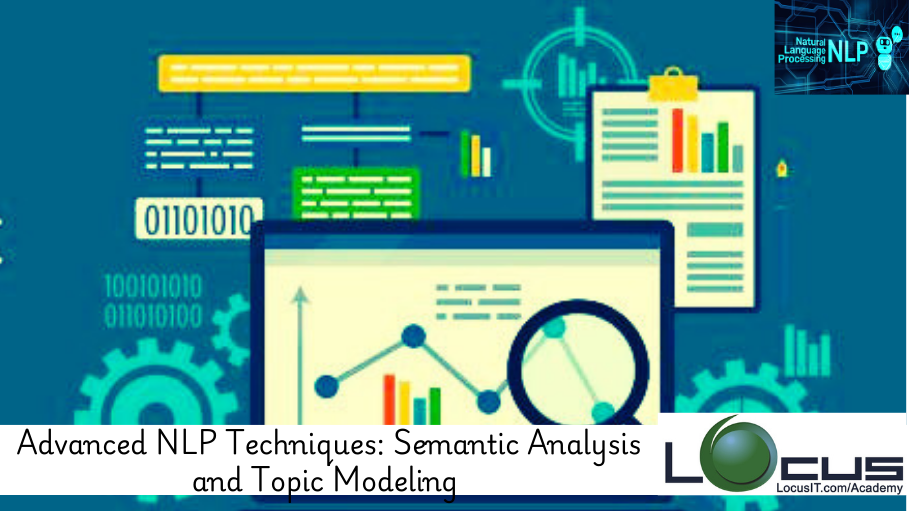Description
Introduction
Advanced Natural Language Processing (NLP) techniques, including Semantic Analysis and Topic Modeling, are critical for understanding the deeper meanings and patterns in large volumes of unstructured text data. Semantic Analysis focuses on understanding the meaning behind words and sentences, considering context and ambiguity. Topic Modeling, on the other hand, is used to uncover hidden thematic structures in a large corpus of text. Together, these techniques can power advanced applications such as content recommendation, customer feedback analysis, and document clustering. This course dives into both concepts, covering foundational theories, algorithms, and practical implementations to solve real-world problems.
Prerequisites
- Basic knowledge of Python programming.
- Familiarity with basic NLP concepts like tokenization, stemming, and lemmatization.
- Understanding of machine learning concepts (classification, clustering).
- Experience with NLP libraries such as SpaCy, NLTK, and Scikit-learn.
- Knowledge of vectorization methods like TF-IDF and word embeddings (optional but helpful).
- Interest in exploring advanced NLP applications such as semantic search, text summarization, and content analysis.(Ref: Named Entity Recognition and Text Classification with NLP)
Table of Contents
- Introduction to Advanced NLP Techniques
1.1 Overview of Semantic Analysis and Topic Modeling
1.2 The Role of Context in Meaning Extraction
1.3 Applications of Semantic Analysis and Topic Modeling in NLP
1.4 Advanced NLP Workflow: Data Preprocessing, Feature Engineering, and Model Evaluation - Semantic Analysis
2.1 What is Semantic Analysis? Understanding Word Meaning and Context
2.2 Word Sense Disambiguation: Identifying the Correct Meaning Based on Context
2.3 Latent Semantic Analysis (LSA): Techniques and Applications
2.4 Word Embeddings: Word2Vec, GloVe, FastText
2.5 Contextualized Word Representations with Transformers: BERT, GPT, and More
2.6 Sentence and Document Embeddings: Using Models like Sentence-BERT
2.7 Hands-on Exercise: Performing Semantic Analysis with Word2Vec and BERT - Topic Modeling
3.1 What is Topic Modeling and Why It’s Important
3.2 Overview of Popular Topic Modeling Algorithms: LDA, LSA, and NMF
3.3 Latent Dirichlet Allocation (LDA): Concepts, Assumptions, and Applications
3.4 Non-Negative Matrix Factorization (NMF) for Topic Discovery
3.5 Evaluating Topic Models: Perplexity, Coherence, and Visualization
3.6 Dynamic Topic Modeling for Time Series Data
3.7 Hands-on Exercise: Implementing Topic Modeling with LDA and Visualizing Results - Advanced Techniques in Semantic Analysis
4.1 Leveraging Pre-trained Transformers for Semantic Analysis
4.2 Sentence-Level Semantic Analysis: Similarity and Sentence Embeddings
4.3 Fine-tuning Language Models for Domain-Specific Semantic Understanding
4.4 Implementing Named Entity Recognition (NER) for Deeper Context Understanding
4.5 Semantic Search: Building Search Engines that Understand User Intent
4.6 Hands-on Exercise: Fine-tuning BERT for Semantic Analysis in Specific Domains - Advanced Topic Modeling Techniques
5.1 Deep Learning Approaches to Topic Modeling: Neural LDA, Variational Autoencoders
5.2 Integrating External Knowledge for Improved Topic Modeling (e.g., WordNet)
5.3 Evaluating Model Performance: Advanced Metrics and Visualizations
5.4 Multi-Topic and Hierarchical Topic Modeling
5.5 Case Study: Using Topic Modeling for Text Classification and Information Retrieval
5.6 Hands-on Exercise: Implementing Advanced Topic Modeling with Deep Learning - Applications of Semantic Analysis and Topic Modeling
6.1 Text Summarization: Extractive vs. Abstractive Methods
6.2 Building Content Recommendation Systems Based on Semantic Analysis
6.3 Sentiment Analysis and Opinion Mining Using Semantic Techniques
6.4 Customer Feedback Analysis: Using Topic Modeling for Insights
6.5 Document Clustering: Organizing Large Collections of Text
6.6 Case Study: Semantic and Topic Modeling for Market Research and Trend Analysis - Improving Model Performance
7.1 Fine-tuning Pretrained Models for Domain-Specific Applications
7.2 Data Augmentation Techniques for NLP Models
7.3 Handling Data Imbalance in Topic Modeling
7.4 Hyperparameter Tuning: Optimizing Your Topic Models and Semantic Analysis Models
7.5 Use of Advanced Transformers for Improved Results in Complex Tasks
7.6 Techniques for Reducing Overfitting in Deep Learning Models - Real-World Deployment of Semantic and Topic Modeling Models
8.1 Deploying Topic Modeling Solutions for Large-scale Text Analysis
8.2 Integrating Semantic Models into Production Systems: APIs and Cloud Platforms
8.3 Best Practices for Scalable and Efficient NLP Deployments
8.4 Continuous Monitoring and Updating of Deployed Models
8.5 Case Study: Real-time Application of Topic Modeling and Semantic Analysis in a Business Context - Tools and Libraries for Semantic Analysis and Topic Modeling
9.1 Overview of Libraries: SpaCy, Gensim, Hugging Face Transformers, Scikit-learn
9.2 Visualizing Topics and Semantic Relationships: PyLDAvis, t-SNE, UMAP
9.3 Advanced Pretrained Models for NLP: BERT, GPT-3, RoBERTa
9.4 Using Cloud-based NLP Solutions for High-Volume Processing (AWS, Azure)
9.5 Real-time NLP Pipelines: Combining Topic Modeling with Streaming Data - Ethical Considerations and Challenges
10.1 Addressing Bias in Topic Modeling and Semantic Analysis
10.2 Privacy and Data Protection in NLP: Ensuring Ethical Use of Text Data
10.3 Explainability in Complex NLP Models: Making Results Interpretable
10.4 Handling Sensitive Text Data: Legal and Ethical Guidelines
10.5 The Future of NLP: Ethical Challenges and Opportunities in Advanced Models
Conclusion
Advanced NLP techniques such as Semantic Analysis and Topic Modeling are pivotal in understanding complex text data and uncovering hidden patterns. In this course, you will gain the skills to build models that not only interpret meaning but also discover thematic structures across diverse text corpora. By combining these techniques with deep learning approaches, you’ll be able to create powerful solutions for real-time data analysis, content recommendations, and trend detection. As these technologies continue to evolve, their application in business intelligence, market research, and customer insights will expand, offering new possibilities for automation and smarter decision-making.







Reviews
There are no reviews yet.